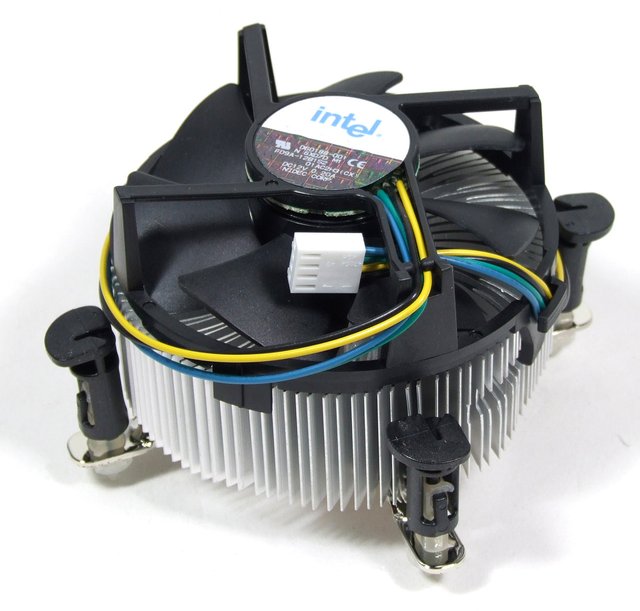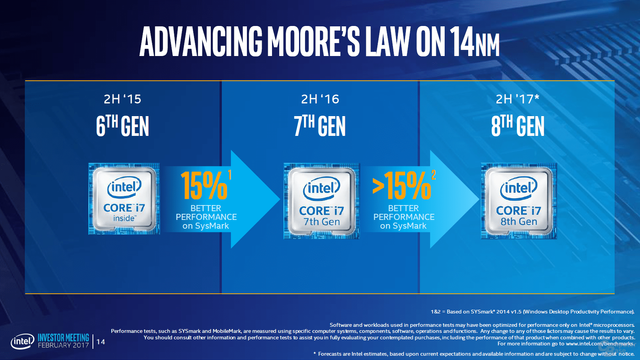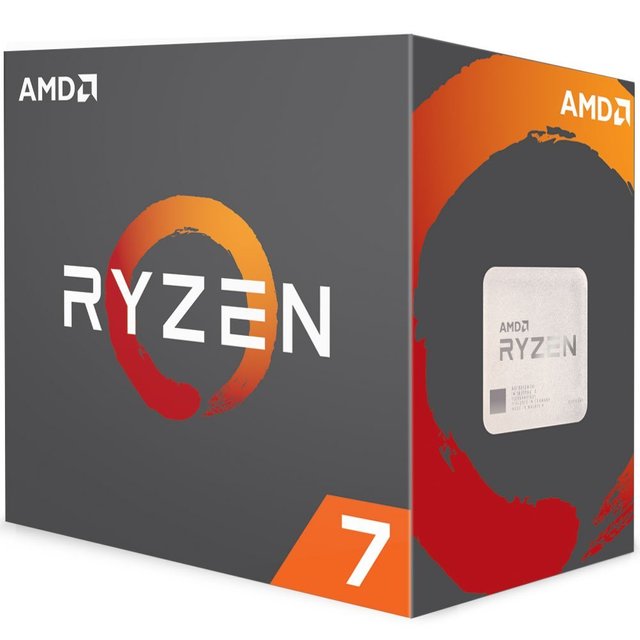Intel’s Core i7-9700K: What We Know (And How It Could Beat AMD)
It’s a tough time to be a PC builder or gamer. Graphics-card prices are astronomical, RAM sits in a similar celestial orbit, and HTC’s new Vive Pro VR headset will set you back $1,200 if you don’t have an existing set of sensors and accessories for HT's previous-generation headset. If you want to play on the leading edge, or anywhere close to it, it will cost you.Indeed, from the PC-component perspective, about the only thing working in favor of increased performance and affordability at the moment is the CPU market.
The Lay of the CPU Land
The launch of AMD’s Ryzen chips last year, which brought eight-core CPUs into the mainstream for the first time, was followed later by Intel’s six-core Core i7-8700K. All of a sudden, the number of cores and threads available for your computing dollar was never better.And that ratio may get better still—AMD’s next-generation Ryzen chips are expected to arrive in April. Leaked reviews of the AMD Ryzen 7 2700X and Ryzen 5 2600 seem to indicate that they are a decent upgrade over the initial Ryzen chips from 2017—especially when it comes to the latency issues that plagued last year’s Ryzen chips in some games.
What’s Intel’s Next CPU Step?
With new Ryzen processors about to roll out, our interest--of course--turns to what Intel will offer up as a response, and as a replacement for chips like the Core i7-8700K. (That key "mainstream flagship" CPU debuted just about six months ago, in early October of 2017.) Let’s take a look at what we know (or at least what we think we know) about the putative Core i7-9700K, and what it will need to compete with AMD’s increasingly tough competition.Multiple rumors and leaks strongly indicate that the ostensible Core i7-9700K will sport eight CPU cores and 16 threads, in contrast to the six cores and 12 threads on the Core i7-8700K. If this turns out to be true, it will be a first for Intel on a mainstream-grade CPU platform—as opposed to the enthusiast-targeted Core X-Series platform, which goes all the way up to 18 cores (if you can afford to drop a couple of grand on a CPU). But the eight cores on the Core i7-9700K, if that turns out to be accurate, only just matches what AMD has to offer in terms of cores and threads on its mainstream Ryzen CPUs; it doesn’t surpass the competition.
10 Nanometer (or Not)?
Of course, a shift to the long-promised 10nm process node would help Intel move further ahead of AMD without necessarily adding more cores. But that’s looking increasingly unlikely with Intel’s next round of desktop chips. Intel’s Gregory Bryant (senior vice president and general manager of the Client Computing Group) proclaimed at CES 2018, back in January, that 10nm chips were shipping to customers. But documents released weeks later seem to confirm that those 10nm “Cannon Lake” parts that shipped in 2017 were low-power, dual-core parts without integrated graphics. These aren’t the Cannon Lake chips that enthusiasts and gamers are looking for.In fact, it’s looking likely that the Core i7-9700K will be a so-called “Coffee Lake Refresh” chip built around Intel’s 14nm++ process. Why do we say that? For starters, we have heard persistent rumors and leaks around an upcoming Z390 chipset. Most recently, a listing for "motherboard-specific sensor info for MSI B360/H310/H370/Z390-Series," showed up in a recent AIDA64 update. (AIDA64 is a benchmark and diagnostic suite often used to test pre-release hardware.)
What a Chipset Tells Us
We now know that the other 300-series chipsets mentioned above are real—in fact, we’ve tested a few motherboards based on them. So there’s no reason to think that a Z390 chipset won’t arrive soon—at Computex 2018 in July, perhaps.Now, the “3” in the Z390 name almost certainly indicates that the chipset is aimed at Coffee Lake CPUs, just like the other 300-series chipsets. What does that tell us? If Intel knew it was going to have 10nm "Cannon Lake" desktop chips ready sometime in 2018, it seems extremely unlikely—though certainly not out of the question—that the company would be launching yet another high-end chipset for its current-generation processors halfway through the year.If we were placing bets, we’d put our chips (pun intended) on the likelihood that Z390 was designed specifically for a line of Coffee Lake Refresh chips, which would include the Core i7-9700K. Alternately, the Core i7-9700K could be a limited stop-gap between chip generations, just like the pair of "Devil’s Canyon" chips were back in 2014.
Can Intel Push Coffee Lake Higher?
Of course, even assuming all the above leaks and assumptions are true, there is quite a lot we still don’t know about Intel’s future mainstream flagship chip. This wikichip page has a fairly detailed spec list based on existing leaks and rumors. It may prove to be accurate, but it doesn’t say anything about clock speed—base clocks or turbo-boost rates. And if the Core i7-9700K is indeed a Coffee Lake chip that doesn't end up featuring architecture or major process-node changes, clock speed (plus core count) would tell us most of what we’d need to know about the performance of this upcoming chip.That said, the Core i7-8700K already has a top Turbo Frequency (at stock settings) of 4.7GHz. It seems likely that, for Intel to set the new chip apart from its predecessor, the stock Turbo clocks would have to hit 5GHz or higher. If Intel can do that, while pushing up the base frequency to about 4GHz and keeping thermal demands in the same 95-watt range of the Core i7-8700K, that indeed would be impressive.
A Lot Comes Down to Pricing
Of course, we don’t know what Intel or AMD will charge yet for their next-generation CPUs. AMD has been extremely price-aggressive since the launch of Ryzen last year, often undercutting Intel’s comparable parts by a significant amount. With its finances now solidly in positive territory for the first time in years, AMD may continue to pressure Intel on chip prices. After all, the CPU underdog is making money and gaining market share with this strategy. So why change it?But CPU prices aside, Intel also faces problems of affordability when it comes to the platform as a whole. AMD’s AM4 boards have been out for a year, and the company says that new CPUs will be backward-compatible with existing AM4 boards (after a BIOS update, of course). Intel’s chips, meanwhile, have not been backward-compatible with previous-generation boards in recent years. And on top of that, Team Blue only just released its lesser 300-series chipsets, after six months of essentially forcing consumers interested in 8th-Generation Core processors to overspend on motherboards—particularly upgraders and builders who don’t care about overclocking, Optane storage, or multiple-graphics-card setups.
Intel Has Options
So, where does Intel stand in the desktop CPU space with next-generation chips like the Core i7-9700K, and what does it need to do to gain ground on its newly resurgent competitor?Offering more cores for less money would be a good start. That seems unlikely in the short term. Offering up more-affordable motherboards that work with more than one processor generation wouldn’t hurt, either. Both tactics seem to be working for AMD, and Intel clearly has the coffers to cut its margins thinner than AMD can.Another interesting option for Intel to compete in today’s world of ever-overpriced graphics cards would be a socketed version of the "Kaby Lake-G" CPU that we just tested in the Intel NUC 8 VR. A custom build around a Kaby Lake-G chip would allow many users to game without the added expense of a graphics card, as well as making truly compact mainstream gaming systems more viable than they have been in the past. Given the rise of titles like Fortnite and Overwatch—which aren’t that graphically demanding—the market could be ripe for just that kind of system. And Intel clearly has some kind of designs on the GPU market, as evidenced by the company’s hire of AMD’s Raja Koduri late last year.But while Koduri is certainly an interesting hire, a socketed Kaby Lake-G is extremely unlikely, given that AMD makes the Vega graphics in those chips. It was surprising to see AMD selling Intel its graphics silicon for comparatively low-volume products such as the new Intel NUC and high-end convertibles like the Dell XPS 15 Convertible. But we highly doubt that AMD is desperate enough to cut into its own core desktop-CPU and graphics businesses by helping Intel compete against itself and its own socketed graphics-equipped products, like the "Raven Ridge" AMD Ryzen 5 2400G.
Hi! I am a robot. I just upvoted you! I found similar content that readers might be interested in:
http://www.tomshardware.com/news/core-i7-9700k-intel-9th-generation,36826.html
Congratulations @djamelddine! You received a personal award!
You can view your badges on your Steem Board and compare to others on the Steem Ranking
Vote for @Steemitboard as a witness to get one more award and increased upvotes!